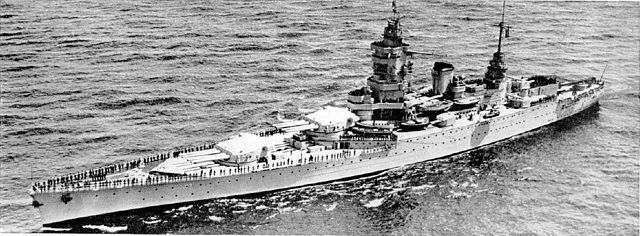Dunkerque-class
Summary
| Origin country | 🇫🇷 France |
| Category | Battleship |
| Subtype | Battleship (World War II) |
| Manufacturer | St-Nazaire |
| Year commissioned | 1937 |
Description
The Dunkerque-class battleships were a pair of French Navy vessels built in the 1930s, significant for being France's first battleships constructed post-World War I, following a hiatus influenced by the Washington Treaty, which aimed to limit naval armaments. Named Dunkerque and Strasbourg, the battleships were conceived as a response to the perceived threats posed by the fast and powerful Italian and German cruisers of the era.
Influenced by naval disarmament agreements and the rising need to counter foreign cruisers, the French Navy proposed various designs, culminating in a final design featuring eight 330 mm guns in two quadruple turrets, heavy enough to challenge Germany's Deutschland-class cruisers. Strasbourg included modifications for thicker armor, responding to new Italian Littorio-class battleships. Despite being smaller and less heavily armed than their contemporaries, which sometimes led them to be called battlecruisers, the Dunkerques were fast battleships designed to fulfill specific strategic needs.
The Dunkerque-class saw brief service; commissioned on the eve of World War II, their operational history included routine deployments, such as visits to Africa and Britain. With tensions escalating, they were assigned to the Force de Raid to combat German commerce raiders. Post-Germany's annexation of France in June 1940, the Treaty of Compiègne ordered the French fleet, including the Dunkerques, to remain docked at Mers-el-Kébir, Algeria.
The British, concerned that the French fleet could fall into Nazi hands, mounted an attack on Mers-el-Kébir. Dunkerque was damaged but Strasbourg managed to escape to Toulon, where she served as the flagship for the High Seas Forces. Dunkerque was temporarily repaired and moved to Toulon for permanent repairs. However, fears of German capture of the French fleet led to the ships being scuttled during Case Anton, the full occupation of Vichy France by Nazi Germany in November 1942.
Dunkerque and Strasbourg remained under Italian control until they were further damaged and eventually captured by Germans, who eventually returned control to the Vichy regime. Following bombings by American forces in 1944 and the conclusion of World War II, the fate of both ships ended with being sold for scrap in the 1950s, after a period of minimal use, including for testing underwater weapons.
The Dunkerque-class battleships embodied advances for the French Navy both in terms of their design, such as the utilization of duel-purpose secondary armament and the incorporation of aircraft facilities, and their machinery, which included a unit system providing improved battle damage resistance. Their main battery was notable for its concentrated forward firepower, reflective of their intended roles, and they boasted substantial secondary and anti-aircraft batteries for their time. Despite efforts to install advanced fire control systems, these often proved unreliable.
The armor layout of the Dunkerque-class adopted the all or nothing approach, with varying armor thickness between Dunkerque and slightly more heavily protected Strasbourg. Their torpedo protection system included innovative features such as liquid-filled voids and a rubber-based substance for better shock absorption. Despite modifications, the unreliability of fire-control systems and other issues were never fully resolved.
Ultimately, these ships led brief and intense service lives marked by their precarious position in the shifting alliances and strategies of World War II, culminating in their scuttling as a dramatic act of self-destruction to deny their use to the enemy, showcasing the tragic dimensions of naval warfare.
Technical specifications
| Dunkerque | |
|---|---|
| Displacement | 26500 tons |
| Range | 14000 km |
| Crew | 1381 members |
| Width | 31.1 m (102.0 ft) |
| Length | 214.5 m (703.7 ft) |
| Propulsion | 6 Rateau boilers with a total power of 135,585 hp - 4 propellers |
| Armament | 8 330mm guns + 16 130mm guns + 10 37mm guns + 8 20mm guns |
| Maximum speed | 30 knots |
Photo of Dunkerque class
